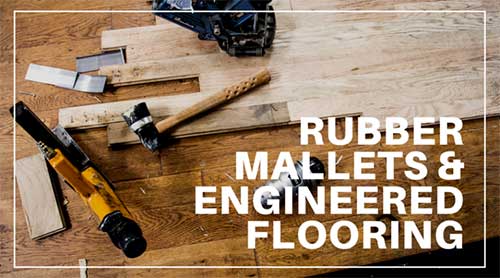
I’ve recently handled a complaint regarding the uses of rubber mallets while installing engineered wood flooring.
The dealer stated that it was industry standard to use a rubber mallet to install engineered wood flooring. Having been an installer for many years, I have used a rubber mallet on several engineered wood floors during installation over the years, with mostly great results. This particular manufacturer installation instructions states:
“NOTE: Never strike a rubber mallets or hammer directly on the flooring to engage the tongue-and-groove. This practice can damage the flooring and/or the finish. Use a tapping block if necessary.”
This got me interested in looking at several other manufacturer installation instructions. I checked online with at least five other large wood flooring manufacturer and found the same kind of warning about NOT using a rubber mallet to install engineered wood flooring.
Mohawk, Anderson, Armstrong, Shaw and Mannington all have their warnings about NOT using rubber mallets to install engineered wood flooring.
Here is what they say:
MOHAWK
“NOTE: DO NOT USE A RUBBER MALLET TO INSTALL FLOORING. STRIKING THE SURFACE WITH A RUBBER MALLET MAY “BURN” THE FINISH CAUSING IRREPARABLE DAMAGE.”
ANDERSON
“NOTE: Never use a rubber mallet or hammer directly on the flooring to engage the tongue-and-groove. This can damage the flooring and/or finish.”
ARMSTRONG
“NOTE: DO NOT INSTALL FLOORING USING RUBBER MALLETS. STRIKING THE SURFACE WITH A RUBBER MALLET MAY “BURN” THE FINISH CAUSING IRREPARABLE DAMAGE.”
SHAW
“NOTE: Never strike a rubber mallet or hammer directly on the flooring to engage the tongue-and-groove. This practice can damage the flooring and/or finish.”
MANNINGTON
“CAUTION: Never use a rubber mallet to tap planks, since this can mark or damage the flooring.”
After being in the wood flooring industry for almost 40 years, I have seen that the practice of using a rubber mallet to engage the tongue-and-groove during the installation has been common practice with of a gluedown, nail/staple down, and even sometimes while floating an engineered wood floor.
Of course this has been done with care and common sense.
I had several types of rubber mallets, of varying weights and sizes, and densities of rubber to accommodate the type of wood flooring I was installing. The first type of rubber mallet had an all white rubber head and a wooden handle, very light weight. Next was a small flooring mallet with a white rubber head generally used for 3/8” or 1/2” wood flooring and then there was the traditional 3/4” flooring mallet with a white rubber head.
The best solution – use a tapping block with the mallet. Don’t use the mallet on the wood itself.
I’ve had success and problems with all of these rubber mallets. The thing is to be able to see the problem early, remedy the problem, and adjust to a better installation method as soon as you see an issue.
With all aspects of installation, it is up to the installer to pay attention to how the floor looks as they’re putting it in. If they see marks on the floor, then they need to stop, figure out what is happening, repair any damage, and then adjust their method of installation.
A major reason manufacturers recommend against using a rubber mallet is that there are many different types of rubber mallets from hard too soft with different types and colors of rubber.
Some are too hard and break the floor, some are too soft and will leave rubber residue on the floor, and some will leave burn marks in the finish. Even if that doesn’t happen, adhesive may get on the mallet head and then be transferred to the surface of the floor. Without proper clean up, adhesive residue cures on the surface or in the wire brushing/texture.
With all the different types of finishes and textures the manufacturers are producing today, it’s not a “one mallet for any floor” solution. The manufacturers will not warranty an installation if there is damage due to the wood flooring by a rubber mallet. You should use a tapping block or whatever their recommended installation procedure is.
I want to be very clear, if you choose to use a rubber mallet to install engineered wood flooring, you will likely pay the price if there is any damage to the wood or the finish.
Just because you have been successful on the last job or for many years doesn’t mean that you will be on the next job. With the next wave of scraped and wire brushed textured floors and the many varieties of finishes, it is wise to be extra cautious and protect yourself from any potential liability.

Tim McCool has been in the wood flooring industry for nearly 40 years as a wood flooring installer, business owner, certified inspector, instructor, and NWFA Advisor.

